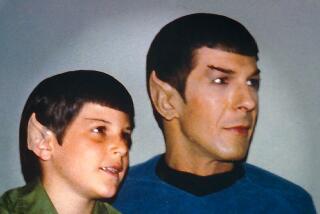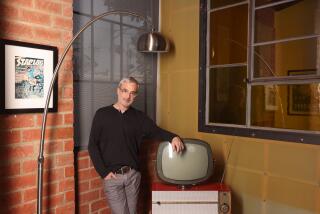Where No Scientist Has Gone Before
- Share via
Award-winning physicist Lawrence Krauss of Case Western Reserve University specializes in cosmic questions such as the age and size of the universe, the origins of matter and the nature of the mysterious “dark matter” that seems to pervade the universe. While Krauss has written several popular books on physics--most notably, “Fear of Physics”--nothing prepared him for the success of his recent bestseller, “The Physics of Star Trek” (HarperCollins, 1995). Translated into nine languages and counting, its just published paperback edition has already sold 75,000 copies. Krauss chatted about the book during a recent visit to Caltech.
Q: What is a nice physicist like you doing writing a book about “Star Trek”?
A: What seduced me was the transporter. It began as a joke between me and my editor. Her daughter was a real Trekker and we were talking about it, and I thought, well, how would I make a transporter? And then I began to think about all the incredible physics that I could introduce in that process.
Q: So you used it as a way to talk about physics?
A: Yeah. I’ve spent a lot of time communicating with the public, and I’ve learned you should never assume that people are interested in what you’re talking about. I think many physicists assume that if they’re clear, then people will be fascinated by what they’re talking about. That’s not the way it is. You have to get people where they are, not where you are. And here was this pop cult icon that captured people’s imaginations.
Q: How much does “Star Trek” have to do with real physics?
A: I think what made “Star Trek” popular for 30 years is that it’s about the possibilities for human civilization. What can happen out there? And of course that’s exactly what physics is all about.
Q: Did you worry about what your colleagues might think?
A: That was scary. Then there’s also the worry about upsetting the vast “Star Trek” following.
Q: Upset the “Star Trek” following?
A: There’s incredible pressure. I had to work harder on this book in many ways than any other book I wrote because there are 20 million “Star Trek” experts out there who are ready to jump if you get something wrong, and I had to watch every episode of “Star Trek” and take notes--four months of midnight-to-5 watching and taking notes.
Yet I didn’t want to cater to pseudoscience. So I had to find a happy medium. And I decided I’ll be right out front when I thought something was impossible. On the other hand you can always say, well, that’s not possible, but it relates to something that might be possible. And have some fun with that. I also decided to be very careful to distinguish between what’s impossible and what’s impractical.
Q: Like?
A: The transporter. I didn’t say [it] was impossible, but the fact that it would take longer than the age of the universe to transfer that much information makes it impractical. And whatever’s impractical will one day happen. I believe that.
Q: Were you always a “Star Trek” fan?
A: I watched it growing up--as have all physicists that I know. One night before I told anyone I was doing this, I decided I wanted to get favorite “Star Trek” bloopers from some famous physicists. So I sent out this e-mail message to Nobel laureates and other people and I thought: Now I’ve blown it. My credibility as a scientist is now over. And within two hours I started getting e-mail back from all of them saying, “Oh, this is my favorite error, or this is.” You know, they all watched it.
Q: That’s really funny.
A: And then I realized it’s gonna be fine, and then of course many of them were relieved when they read the book and saw this really is a physics book.
Q: How did the Trekker community react?
A: The reaction has been, “This is what we’ve been waiting for. We really didn’t know what was true and what wasn’t.” One of my first letters was from some guy who said he’d been waiting 30 years to finally be able to buy a “Star Trek” book in the science fact section of a bookstore. The reaction has also been great from young kids, 8, 9, 10. I never had kids that young read anything I wrote that I knew of.
Q: And they follow it, I mean they seem to understand it?
A: You know they understand it, obviously at different levels, but some of them come and ask really neat questions after lectures.
Q: What’s the worst science in “Star Trek”?
A: Probably the worst aspect, and the thing that makes scientists most envious, is that in every episode they come up with these incredibly near-impossible challenges and problems to be solved, and they always solve it in an hour. The other thing that is unrealistic--although in some sense it’s what makes the “Star Trek” world so neat--is that every single person in the 23rd century is scientifically literate. Even the psychologist is always talking about physics and stuff.
Q: And what about out-and-out bloopers?
A: Sound in space, that’s a big blooper. [The creators knew] there’s no sound in space, but without it, you’re not gonna go into syndication.
Q: What else?
A: In one episode, they decide to increase the power by one to the 12th power.
Q: That equals one.
A: Right. There’s a lot of that ‘cause what they do is they borrow the jargon and sometimes they blow it. But often they were incredibly accurate without knowing they would be, about things that they had no right to get right.
Q: Example?
A: My favorite example is in one of the early episodes, when they go too close to a gravitational field of a “black star.” And when I saw that, I thought, well, the writers don’t know about black holes, and didn’t get it quite right. Then I looked at the air date and I found out it was written six months before [physicist] John Wheeler invented the word “black hole.” So they almost invented the word “black hole.”
Q: Wow. Do you think that’s just a coincidence?
A: My feeling is that it’s just creative people thinking. And it’s not too surprising that creative people thinking often come up with similar solutions to problems.
Q: Such as?
A: Well, in “Star Trek,” noninvasive medical scanning, the fact that they didn’t have to go inside the body. Well, there wasn’t CAT scanning and there wasn’t MRI scanning then. Another example is, I don’t think my cell phone would flip open if it weren’t for the “Star Trek” communicator.
Q: Has writing the book had an effect on your physics?
A: Every time I try to explain something, it has an effect on my physics. Every time you try and explain something, you understand it differently. Also, I hadn’t really spent a lot of time thinking about time travel, for example. I knew that people were working on it, but I had to think about it a lot more carefully and understand it.
More to Read
Sign up for our Book Club newsletter
Get the latest news, events and more from the Los Angeles Times Book Club, and help us get L.A. reading and talking.
You may occasionally receive promotional content from the Los Angeles Times.








